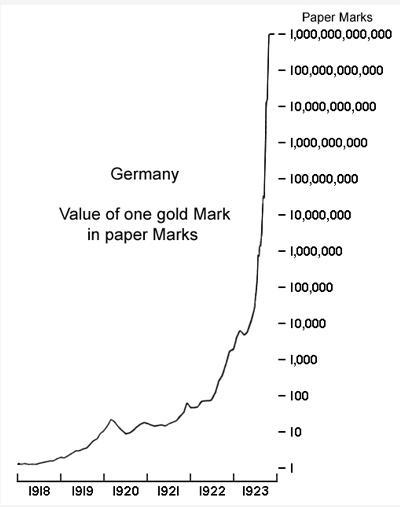Use the graph below to answer the following question:
A line graph of the Weimar Republic depicting the value of one gold mark per paper mark in the years 1918 to 1923. Between 1918 and 1922, values fluctuate between approximately 3 gold marks in paper marks to 10,000. By 1923, it reaches its peak at 1,000,000,000,000 paper marks to one gold mark.
Public Domain
Which of the following best explains the graph above?
The high reparations against Germany
The Dawes Plan investing American dollars into Germany
Germany printing more and more money
The Germans losing a trade partner when Russia became the Soviet Union

Answers
The value of the German paper mark in terms of gold marks from 1918 to 1923 is shown in the graph above.
Which of the following best explains the graph above?The hyperinflation brought on by Germany printing ever-increasing amounts of money to pay its war debts and reparations imposed by the Treaty of Versailles is what caused the sharp rise in value beginning in 1922 and peaking in 1923, reaching a ratio of 1,000,000,000,000 paper marks to one gold mark. As a result, the graph's best explanation is that Germany continued to print more money, which decreased the paper mark's value relative to gold marks. The Dawes Plan, high reparations against Germany, and the loss of a trading partner were some of the other options that may have some impact on the German economy, but they do not directly explain the drastic increase in inflation depicted in the graph.
To Know more about Hyperinflation Visit:
brainly.com/question/30437654
#SPJ1
Answer: Germany printing more and more money
Explanation:
Related Questions
which type of evidence mostly likely include a testimonial
Answers
Answer: Testimonial evidence is a statement made under oath.
Explanation:
An example would be a witness pointing to someone in the courtroom and saying, “That's the guy I saw robbing the grocery store.” This is also called direct evidence or prima facie evidence.
Judges in federal appellatecourts determine whether
Answers
The task of the appellate court is to determine whether or not the law was correctly applied in the trial court. Appeals courts have three judges and no jury.
In India, what exactly is an appeal court?
The ability of a court to hear/review a case decided by a lower court is referred to as appellate jurisdiction. Both the Supreme Court and the High Courts have appellate jurisdiction in India. They have the authority to reverse or uphold lower court rulings. The first appeal is made to an officer designated by the public authority as the First Appellate Authority within the public authority itself. The CPIO has less authority than the First Appellate Authority. The Central Information Commission will consider the second appeal.
To know more about judges visit:-
https://brainly.com/question/1078357
#SPJ9
What is yellow journalism?
A) Articles written based on the author’s opinion.
B) Articles written by authors known for exaggerating the facts, often not providing any evidence for their claims.
C) Articles written to slander people in the press.
D) Articles written by authors known for reporting facts and providing evidence for claims.
Answers
Answer:
B) Articles written by authors known for exaggerating the facts, often not providing any evidence for their claims.
B) Articles written by authors known for exaggerating the facts, often not providing any evidence for their claims.
Yellow journalism refers to a style of journalism that is characterized by sensationalism, exaggeration, and often unethical practices such as the use of misleading headlines, fake news, and false information. It is typically associated with the late 19th and early 20th centuries when newspapers competed with each other to attract readership through sensational stories, often involving crime, scandal, and gossip.
Option B is the closest to the definition of yellow journalism, as it emphasizes the use of exaggerated and unsupported claims. Option A may describe opinion journalism, while options C and D are not accurate descriptions of yellow journalism.